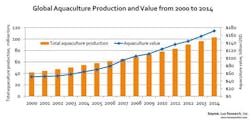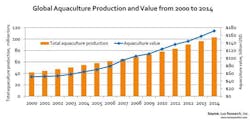Secondary wastewater treatment improved with passive aeration, process control, report finds
BOSTON, MA, Jan. 13, 2015 -- According to a new report from Lux Research, a provider of strategic advice and ongoing intelligence for emerging technologies, traditional options for secondary wastewater treatment consume high amounts of energy -- 68 GWh annually in the U.S. alone -- and still leave excessive remnants of sludge.
Analysis from the report, titled "Advances in Secondary Wastewater Treatment," indicates that there is a dire need to improve this secondary wastewater treatment with increasing pressure from growing populations and more frequent severe storm events.
As a result, a collection of new technologies is expected to transform wastewater treatment. For example, successful systems dramatically simplify the wastewater process and easily scale down to serve the wide array of small utilities in the market. These technologies harness passive aeration to reduce energy costs and fine tune the microbial population to significantly reduce sludge production.
"Technologies like membrane bioreactors emerged to improve the quality of wastewater treatment but don't address the energy and sludge concerns, and the smallest facilities struggle to implement them effectively," said Tess Murray, Lux Research associate and lead author of the report. "Now, new startups are fundamentally rethinking wastewater treatment and effectively addressing energy consumption and sludge generation, which together account for nearly half of the operating costs at today's plants."
Lux Research analysts observed the current wastewater treatment landscape and evaluated five innovative secondary wastewater treatment technologies available. Their findings include the following:
- Growing population and climate pressure force capacity expansions. The frequency of extreme storm events has increased about 30 percent in the U.S. over the past 67 years, with states in the Northeast hardest hit. The resulting increase in stormwater, combined with a growing population, puts pressure on treatment facilities.
- Electricity and sludge management are almost half of a plant's operating costs. Sludge transport and disposal accounts for about a quarter of wastewater treatment plant operating costs, and only about 40 percent of leftover sludge is put to beneficial use in the U.S. (e.g., spread on land as a low-grade crop fertilizer).
- Successful systems have a variety of ideas for implementing passive aeration. The best alternative systems offered by companies such as Baswood and Aquarius Technologies, for example, find new ways to provide the oxygen that microbes need, reducing energy consumption by as much as 50 percent and sludge production by as much as 90 percent. The combination of savings accumulates and could save the average wastewater treatment plant as much as $1.1 million in operating expenses per year.
See also:
"Lux Research: The top global water research institutes"
"Lux Research: Recovering oil and precious metals from wastewater creates new revenue streams"
About Lux Research
Lux Research provides strategic advice and ongoing intelligence for emerging technologies. Leaders in business, finance and government rely on us to help them make informed strategic decisions. Through our unique research approach focused on primary research and our extensive global network, we deliver insight, connections and competitive advantage to our clients. For more information, visit www.luxresearchinc.com.
###

